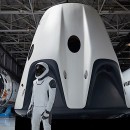I’m not entirely sure “mildly disintegrated” is a thing, but this phrase seems to perfectly describe the things you can see in the very short video attached below: bits and pieces flying off the Starship SN20 (alternatively S20) prototype.
SN20 is the name SpaceX gave to the latest incarnation of the Starship. It’s the one that is supposed to reach orbit and officially give birth to a new family of space vehicles in the company’s portfolio.
The ship presently on the launch pad in Texas, where it is conducting testing prior to the actual departure, which could happen by the end of the year. This week, SpaceX conducted an ambient pressure test, and that is when this mishap happened. What you’re looking at are apparently heat shield tiles that were blown off during the test.
The tiles, connected to the Starship by means of steel studs, should have had no reason to abandon their post. The exact cause of the incident was not disclosed, but Elon Musk did confirm in a tweet that the “headed tank vent knocked off a few tiles.”
The SN20 is the first in the line of Starships that will require a heat shield. The many previous versions only flew inside the atmosphere, so no re-entry was required. This one, however, will have to survive temperatures that could reach as much as 2,500 degrees Fahrenheit (1,400 degrees Celsius).
It’s unclear at this point if the incident caused any damage to the ship itself, but it is unlikely it would be enough, by itself, to affect the schedule. Up next are a cryogenic test, and the moment all space enthusiasts are waiting for, the make-it-or-break-it static fire test.
If successful, the Starship will open up the solar system for SpaceX. Unlike the Crew Dragon, which is designed to go up to the International Space Station and back, this one is heading for the Moon and, in some later versions, maybe even for Mars, with people on board.
The ship presently on the launch pad in Texas, where it is conducting testing prior to the actual departure, which could happen by the end of the year. This week, SpaceX conducted an ambient pressure test, and that is when this mishap happened. What you’re looking at are apparently heat shield tiles that were blown off during the test.
The tiles, connected to the Starship by means of steel studs, should have had no reason to abandon their post. The exact cause of the incident was not disclosed, but Elon Musk did confirm in a tweet that the “headed tank vent knocked off a few tiles.”
The SN20 is the first in the line of Starships that will require a heat shield. The many previous versions only flew inside the atmosphere, so no re-entry was required. This one, however, will have to survive temperatures that could reach as much as 2,500 degrees Fahrenheit (1,400 degrees Celsius).
It’s unclear at this point if the incident caused any damage to the ship itself, but it is unlikely it would be enough, by itself, to affect the schedule. Up next are a cryogenic test, and the moment all space enthusiasts are waiting for, the make-it-or-break-it static fire test.
If successful, the Starship will open up the solar system for SpaceX. Unlike the Crew Dragon, which is designed to go up to the International Space Station and back, this one is heading for the Moon and, in some later versions, maybe even for Mars, with people on board.
Headed tank vent knocked off a few tiles
— Elon Musk (@elonmusk) September 27, 2021
Don't want that kind of thing when it's flying.... pic.twitter.com/nPGbcCvkw5
— Scott Manley (@DJSnM) September 28, 2021


































